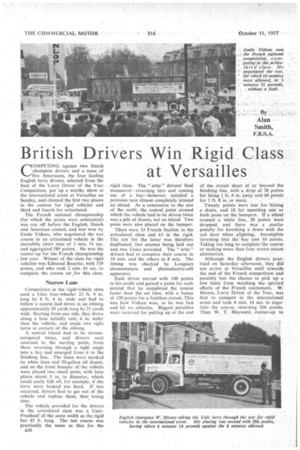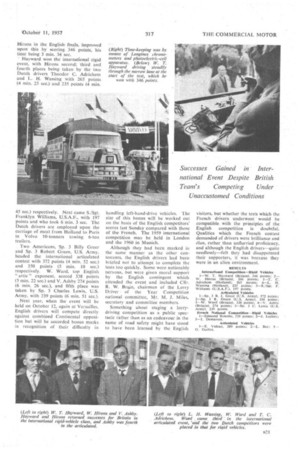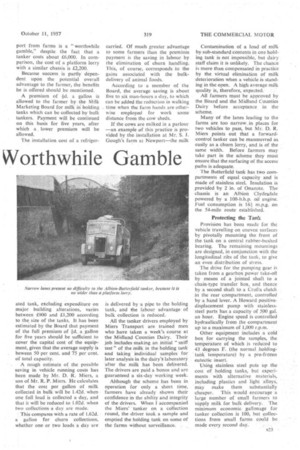British Drivers Win Rigid Class at Versailles
Page 54

Page 55

Page 57

If you've noticed an error in this article please click here to report it so we can fix it.
C°MEETING against two Dutch champion drivers and a team of five Americans, the four leading English lorry drivers, selected from the final of the Lorry Driver of the Year Competition, put up a worthy show at the international event at Versailles on Sunday, and claimed the first two places in the contest for rigid vehicles and third and fourth for articulated.
The French national championship (for which the prizes were substantial) was run off before the English, Dutch and American contest, and was won by Emile Vidcau, who negotiated the test course in an articulated vehicle in the incredibly short time of 3 min, 51 sec, and aggregated 589 points. He was the runner-up for the French championship . last year. Winner of the class for rigid vehicles was Edmond Bonetto, with 539 points, and who took 2 min. 41 sec. to complete the course set ,for this class.
Narrow Lane
Competitors in the rigid-vehicle class used a Unic four-wheeler 23 ft. 4 in, long by 8 ft. 4 in, wide and had to follow a course laid down in an oblong approximately 50 yards long by 25 yards wide. Starting from one side, they drove along a lane initially only 6 in. wider than the vehicle, and made two right turns at corners of the oblong.
A central island had to be circumnavigated twice, and drivers next returned to the starting point, from there reversing through a right angle into a bay and emerged from it to the finishing line. The lanes were marked by white lines and 50-gallon oil drums, and on the front bumper of the vehicle were placed two small posts, with base plates about 5 in. in diameter, which could easily fall off, for example, if the lorry were braked too hard. If this occurred, drivers had to get out of the vehicle and replace them, thus losing time, • The vehicle provided for the drivers in the articulated class was a UnicFruehauf of the same width as the rigid but .45 ft. long. The test course was practically the same as that for the B20
rigid class. The ." attic" drivers' final tnameuvre—reversing into and coming out of a bay—however, entailed a previous turn almost completely around an island. As a concession to the size of the outfit, the central point around which the vehicle had to be driven twice was a pile of drums, not an island. Two posts were also placed on the bumper.
There were 33 French finalists in the articulated class and 63 in the rigid. The test for the latter was therefore duplicated, two courses being laid out and two Unics provided. The " artic " drivers had to complete their course in 10 min. and the others in 8 min. The timing was checked by Longines chronometers and photoelectric-cell apparatus.
Each driver started with 100 points to his credit and gained a point for each second that he completed the course faster than the set time, with a bonus of 120 points for a faultless circuit. This was how Videau won, as he was fast and hit no obtacles. Biggest penalties were incurred for pulling up at the end of the circuit short of or beyond the finishing line, with a drop of 30 points for being 1 ft. 4 in away and 60 points for 1 ft. 8 in. or more.
Twenty points were lost for hitting adrum, and 10 for upsetting one or both posts on the burnperS. If a wheel crossed a white line, 20 points were dropped, and there was a similar penalty for knocking a drum with the cab door when alighting. Incomplete reversing into the bay cost 10 points. Taking too long to complete -the course or making more than four errors meant Although the English drivers practised on Saturday afternoon, they did not arrive at Versailles until towards the end of the French competition and possibly lost the chance to pick up a few hints from watching the spirited efforts of the French contestants. W.' Hirons, Lorry Driver of the Year, was first to compete in the international event and took 4 min. 14 sec. to negotiate the course, returning 266 points. Then W. T. Hayward, runner-up to
Hirons in the Englishfinals, improved upon this by scoring 346 points, his time being 3 min. 34 sec. ' Hayward won the international rigid event, with Birons second; third and fourth places being taken by the two Dutch drivers Theodor C. Adrichem and L. H. Wassing with 265 points (4 min. 25 sec.) and 235 points (4 min.
45 sec.) respectively. Next came S./Sgt. Franklyn Williams, U.S.A.F., with 197 points and who took 6 min. 3 sec. The Dutch drivers are employed upon the carriage of meat from Holland to Paris in Volvo 10-tanners towing 6-ton trailers.
Two Americans, Sp. 3 Billy Greer and Sp. 3 Robert Green, U.S. Army, headed the international articulated contest with 372 points (4 min. 52 sec.) and 350 points (5 mm. 10 sec.) respectively. W. Ward, top English " artic " exponent, scored 338 points (5 min. 22 sec.) and V. Ashby 274 points (6 min. 26 sec.), and fifth place was taken by Sp. 3 Charles Lewis, U.S. Army, with 239 points (6 min. 51 sec.).
Next year, when the event will be held on October 12, again at Versailles, English drivers will compete directly against combined Continental opposition but will be accorded bonus marks in recognition of their difficulty in handling left-hand-drive vehicles. The size of this bonus will be worked out on the basis of the English competitors' scores last Sunday compared with those of the French. The 1959 international competition may be held in London and the 1960 in Munich.
Although they had been marked in the same manner as the other contestants. the English drivers had been briefed not to attempt to complete the tests too quickly. Some were noticeably nervous, but were given moral support by the English contingent which attended the event and included alr. R. W. Bra.in, chairman of the Lorry Driver of the Year Competition national committee, Mr. M. J. Miles, secretary and committee members.
Something about staging a lorrydriving competition as a public spectacle rather than as an endeavour in the name of road safety might have stood to have been learned by the English
visitors, but whether the tests which the French drivers underwent would be compatible with the principles of the English competition is doubtful. Qualities which the French contest demanded of drivers were brilliance and elan, rather than unflurried proficiency. and although the English drivers—quite needlessly—felt they had disappointed their supporters, it was because they were in an alien environment.
port from farms is a "worthwhile gamble," despite the fact that a tanker costs about £6,000. In comparison, the cost of a platform lorry with a similar chassis is £2,200.
Because success is partly dependent upon the potential overall advantage to the farmer, the benefits he is offered should be mentioned.
A premium of id. a gallon is allowed to the farmer by the Milk Marketing Board for milk in holding tanks which can be collected by bulk tankers. Payment will be continued on this basis for five years, after which a lower premium will be allowed.
The installation cost of a refriger carried. Of much greater advantage to some farmers than the premium payment is the saving in labour by the elimination of churn handling. This, of course, corresponds to the gains associated with the bulkdelivery of animal foods.
According to a member of the Board, the average saving is about five to six man-hours a day, to which can be added therednction in walking time when the farm hands are otherwise employed for work some distance from. the cow sheds.
If the cows are milked in a parlour —an example of this 'practice is provided by the installationat Mr. S. J. Gough's farm at Newport—the milk Contamination of a load of milk by sub-standard contents in one holding tank is not impossible, but dairy staff claim it is unlikely. The chance is more than compensated in practice by the virtual elimination of milk deterioration when a vehicle is standing in the open. A high average milk quality is, therefore, expected: All farmers must be approved by the Board -and the Midland Counties Dairy before acceptance in the scheme. • Many of the lanes leading to the farms are too narrow, in places for two vehicles to pass, but Mr. D. R. Miers points out that a forward-control tanker can be manceuvred as easily as a churn lorry, and is of the same width. Before farmers may take part in the scheme they must ensure that the surfacing of the access paths is adequate.
The Butterfield tank has two compartments of equal capacity and is made of 'stainless steel. Insulation is provided by 2 in. of Onazote. The chassis is an Albion Clydesdale powered by a 100-b.h.p. oil engine. Fuel consumption is 164 m.p,g. on the 54-mile route established.
Protecting the Tank Provision has been made for the vehicle travelling on uneven surfaces by pivotally mounting the front of the tank on a central rubber-bushed bearing. The remaining mountings are designed, in conjunction with the longitudinal ribs of the tank, to give an even distribution of stress.
The drive for the pumping gear is taken from a gearbox power take-off by means of a jointed shaft to a chain-type transfer box, and thence by a second shaft to a Crofts clutch in the rear compartment, controlled by a hand lever. A Howard positive• displacement pump with stainlesssteel parts has a capacity of 500 gal. an hour. Engine speed is controlled hydraulically from the compartment up to a maximum of 1,000 r.p.m.
Other equipment includes a cold box for carrying the samples, the temperature of which is reduced to 43 .degrees F. (the normal holding' tank 'temperature) by a pre-frozen eutectic -insert.
Using stainless steel puts up the cost of holding tanks, but experiments with alternative materials, including plastics and light alloys, may make them substantially cheaper. This would encourage a large number of small farmers to supply milk for bulk delivery. The minimum economic gallonage for tanker collection is 100, but collections from small farms could be made every second day.




















































































































